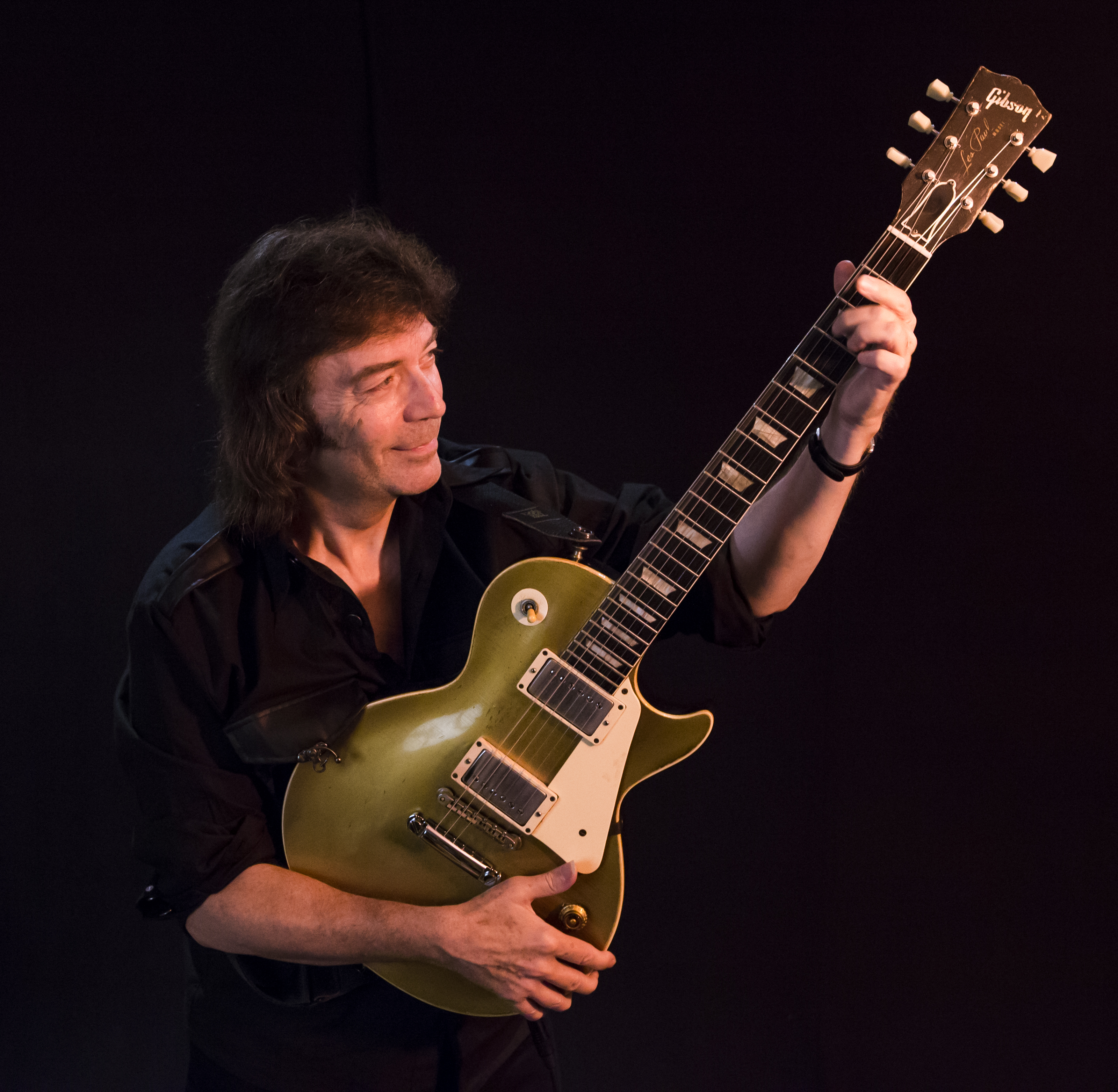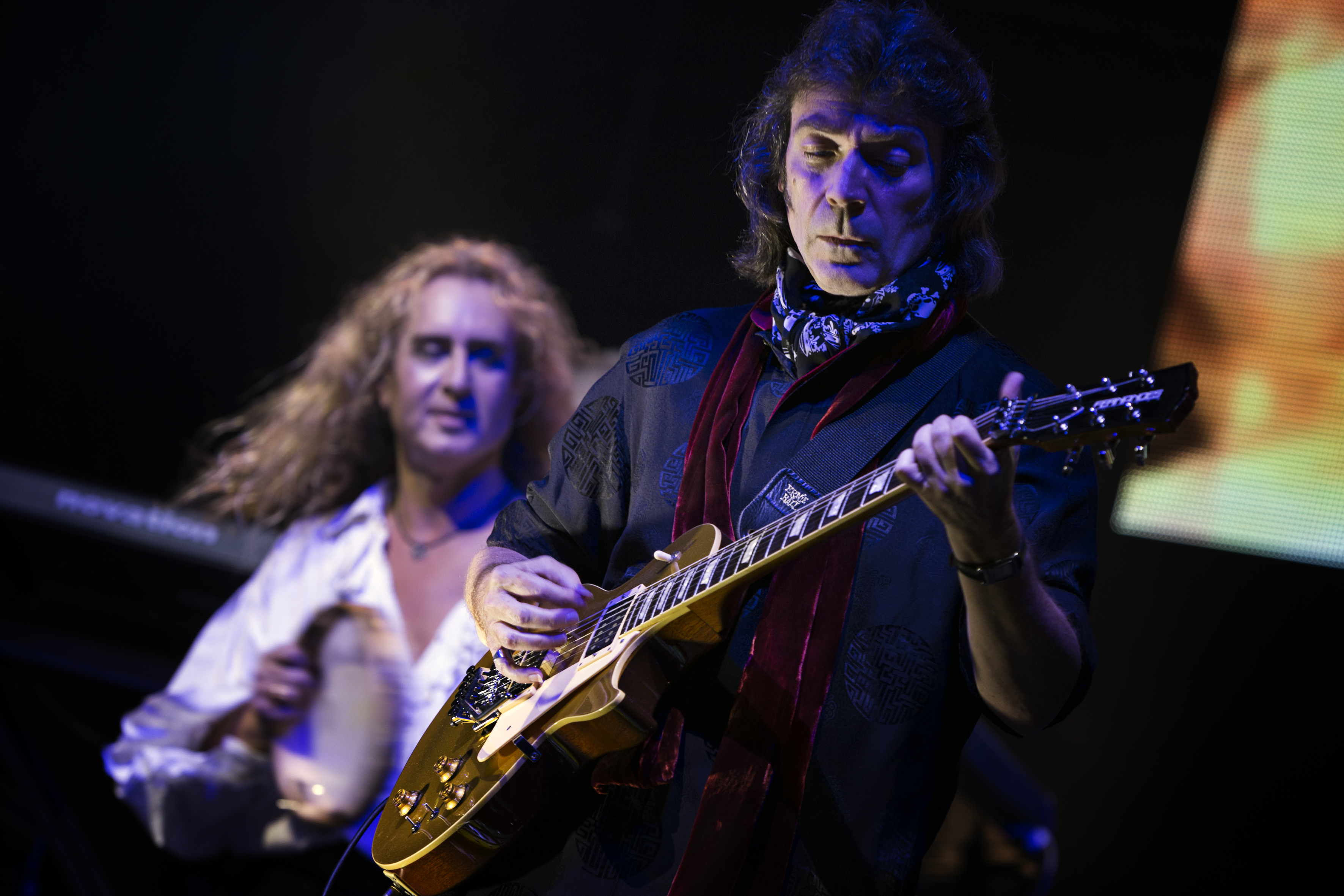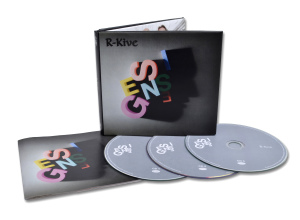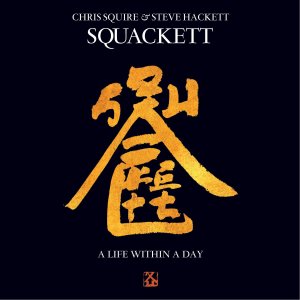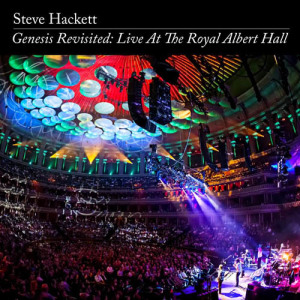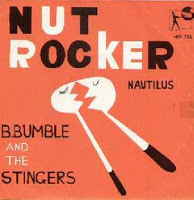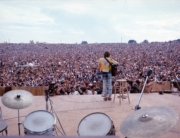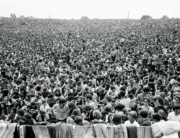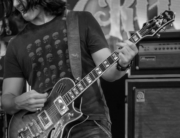BY MIKE METTLER — NOVEMBER 26, 2014
“I personally like to be surrounded and ambushed by music. I want it to surprise me, and I want it to come from surprising places,” says Steve Hackett, echoing the sentiments of scores of audiophiles the world over. The progressive-minded guitarist has been enjoying accolades for the depth, compositional excellence, and overall live sound quality evident on his Genesis Revisited II 2013/2014 tour — so much so that a number of additional legs, dubbed Genesis Extended, have been added to his touring palette through next spring, at which time he’ll focus his energies on a new solo album release. Of that forthcoming new music, he says, “I like to think about it as a rock album with a difference. It’s very much like having scenes from a film for the ear rather than the eye.”
Said new disc was mixed in surround by Hackett’s keyboardist and production partner Roger King, who also helmed the surround mixes for two enveloping Genesis Revisited II live offerings from 2013 — Live at Hammersmith and Live at The Royal Albert Hall — as well as Squackett’s A Life Within a Day, his 2012 studio collaboration with Yes bassist Chris Squire.
Hackett, 64, and I got on the line a few days before he headed back out on the road for the next leg of the Genesis Extended tour to discuss how to create “inhabitable” music, his personal favorite Genesis surround mixes, and the three “Bs” that comprise his earliest influences. Hadn’t you heard? He’s a supersonic scientist.
Mike Mettler: You and Roger King are such a good team in terms of knowing what you want to get out of your surround mixes and how to make listeners feel we’re right in the middle of them. Do you think surround sound the best listening format? Especially considering how near and dear this music is to you, you must want to evoke certain specific things with it.
Steve Hackett: Well, I do. I think that it’s great. What we try to do is address the fact that there are so many people who swear that their own listening medium is “The One” — the one true God. (MM laughs) Vinyl is that medium for some, and it’s CD for others, DVD for others, and Blu-ray for others. You know what I’m saying. It’s a multi-dimensional listening market. And the fight-back for audio is in making the package, including all of those forms, as attractive as possible.
We survivors like to think that we’re trying harder. It feels like things are getting better, as far as I’m concerned. I know people are talking about the contracting market, but at the end of the day, yeah, it always was tough to be in showbiz. But on the other hand, yes, it must have been great to have been around in the 1950s with a handful of rock & roll artists, and there wasn’t too much competition around — perhaps. But now, there are hundreds of thousands of them. Everyone can make a record and everyone can be a star. What distinguishes you? What makes you different than everyone else? I keep asking myself that. Just to try and get to the heart of the music. I like to think I’m flexible.
Mettler: And because there is so much music now, what I think we find is that quality endures, and the material you created some 40 years ago is as vital today as it was then. And you’re finding that, besides those of us who grew up with it, other generations are coming in to find out why this is better than that.
Hackett: Yes. Why do people still buy Bach? Why do they still buy Miles Davis? Why do they still buy The Beatles? It’s because that stuff endures beyond any marketing man’s dream. The quality is there in terms of the writing — and that alone ought to be the yardstick, rather than thinking, “Well, actually, I’m going to parade my private life and sell it on that and the photograph and the image.” All that reached its zenith in the ’80s, of course, but I think that we’re in a post-image-driven time now. I think it’s possible for people to do what the hell they want at this time — as long as it’s good.
Mettler: The quality level of the material you choose to perform in the Genesis Revisited context is at an incredibly high standard.
Hackett: Yes, it’s been extraordinary, really. They shows have been extraordinary, and the response has been extraordinary. But I’m also getting a tremendous amount of people who are coming to sold-out theaters, saying, “Yeah, but what about your solo stuff?” Well, I spent 2 years bringing back the dream that was Genesis to people — the dream of the five-man team of Genesis during the Gabriel-Collins-Banks-Rutherford-Hackett era. And I’ve brought back that music that was at its most creative, I feel. But of course whatever you do, it’s at the expense of something else, so I have managed to shoehorn in the time when I haven’t been out on the road — and this past year, I’ve done 20 countries. It’s not been a time for sitting back. It’s been a really thrilling time. It’s been a fantastic, extraordinary time, and the friends that I’ve worked with also happen to be doing very well themselves. For instance, I was working with Jakko Jakszyk on the Genesis Revisited II (2012) album [on “Entagled,” Disc 2, Track 3, originally from A Trick of the Tail], and he’d subsequently been chosen to be part of the new version of King Crimson, and I’m thrilled for him because that’s a dream, and good for him.
Mettler: Yes, I got to see him at three of the shows King Crimson did in New York [September 18, 20, and 21, 2014, at Best Buy Theater, New York City], and we talked a bit about that after the third show.
Hackett: Oh, fantastic! Marvelous. He joined us on our London show [November 1 at the Eventim Apollo]. In terms of others — our singer, Nad Sylvan, always wanted to be the Genesis singer, so this has been a dream come true for him.
Mettler: He embodies it so well, too.
Hackett: He does it very well. He’s flamboyant — he’s on a planet of one, really. There’s no one like him. Highly idiosyncratic and highly theatrical. And audiences have really taken to him, which is really marvelous. And once we’re done with Genesis Extended, I can’t wait to play the new album for people live next year. We will be touring it.
Mettler: So there’s no rest for you, Steve. No sleep allowed.
Hackett: Oh, I do get sleep, but my mother says to me, “How do you manage to keep up with all of this?” — and she knows I live out of a suitcase — so I said, “Well, that’s what we do.” You get to the point where you’ve done enough shows that the entire team can do it when they’re completely exhausted yet still manage to keep it fresh, because it does become second nature. But then, I still do absolutely love it and adore it, and that’s what gives you the energy to carry on. The shows get looser, but they get more confident, in a way. The whole team still seems to be able to keep it close to the original plot, the original dream.
Mettler: Speaking of the original dream, let’s talk about the Genesis R-KIVE project that came out on September 30 [a three-disc retrospective, on Rhino].
Hackett: The R-KIVE idea was one where, not only did it throw light on the Genesis back catalog with those 37 tracks, each of the five of us were asked to contribute three solo tracks. It was pretty much our manager Tony Smith’s idea — well, he says it was (chuckles) — so there were three solo tracks from each of the participants. So you have the idea of the best of the band and a cross-section of what we’ve done as individuals.
Mettler: From you, we get “Ace of Wands” on the first disc [from 1975’s Voyage of the Acolyte] and “Nomads” [from 2009’s Out of the Tunnel’s Mouth] on the third disc, which are nice bookends to show the scope of what you do.
Hackett: Yes — and also via “Every Day” on Disc 2, which is from Spectral Mornings in 1979. It goes ’75 to ’79, and then 2009. Some of that stuff is 30 years apart, of course, but I wanted to show some things that were typical, and then something that was atypical of Genesis, something flamenco-based.
Mettler: That’s what you wanted to do in your solo universe — embrace the full swath of your style.
Hackett: Well, that’s right. I’ve always wanted to expand what I could do on a nylon guitar, and include that in what I do. Obviously, nylon guitar is a very self-sufficient thing. It’s like sitting down to a piano, if you want a vast array of tone colors. It’s not the only way of course, but it will work in a band context. The rhythmic textures have got to be lighter in order to support that. But nylon can fire off salvos in the same way electric guitar can.
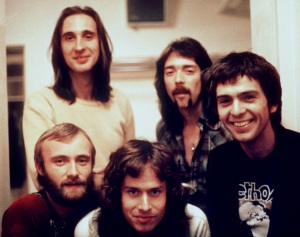
Then-esis: Clockwise, from top left — Rutherford, Hackett, Gabriel, Banks, and Collins, in more hirsute times.
Mettler: I did get to speak with Mike Rutherford about R-KIVE in early September, and we were both saying how nice it was to have “Supper’s Ready” included [from 1972’s Foxtrot], because it certainly could have been cut since it takes up a lot of time.
Hackett: It certainly does, yes.
Mettler: I’m sure you’d agree it’s a critical, early track in the Genesis canon.
Hackett: I think so, yeah. It was actually written quite quickly, considering the length of it, 23 minutes [23:04, to be exact]. To my recollection, it was written in 2 weeks, so we were going at some considerable pace at that time. Obviously, there were ideas that individuals had come up with that may have dated back much earlier, but nonetheless it’s something that, when we played it live originally, audiences were completely mystified by it. And then it became an absolute favorite.
And then of course you jump ahead to now, and many see it as their favorite progressive track of all time, according to certain magazines. Whether it’s the zenith of the format I don’t know, but it may well be [one of] the longest tunes ever written; I’m not sure. I’m sure there’s someone else out there somewhere in ancient China who’d written something much longer (MM laughs), but that wasn’t our intention. It was merely that we were seguing so many bits with the atmospheres that could join them, and creating bridge passages. The challenge was always on to combine disparate genres of music with a sufficiently good bridge passage.
And that, in a way, is how I still function. I nail my colors to the mast in terms of saying, “Here’s the challenge.” You write a piece of music that’s not just a listening experience, but it’s a journey, and a continuum of sorts. It fits the bill for classical listeners in terms of program music — this idea of something that’s scenic, like different aspects of a film with different characters wandering in and the challenge of telling a story over time. It’s like creating music as an environment for people to inhabit.
If you’ve done your job properly with any song — whether it’s a 3-minute song or a 30-minute song — ideally what you’ve done is create a world that relates to itself. That’s what I think of when I think of my favorite tunes. Back in the day, there were certain songs I heard that I thought, “Well, I can really live inside that one. I understand what it’s trying to say.” It’s certainly a magical ride. So that’s the challenge for musicians, isn’t it — to make music that’s absolutely indispensable.
Mettler: I have to say the 5.1 mix of “Supper’s Ready” that Nick Davis did for the early Genesis “cube” box set [1970-1975] really makes you feel like you’re sitting inside the audio movie that’s unfolding all around you.
Hackett: I think so, yes. If the job is already done and you already enjoy the song, to my mind, I feel you can be ready for that. Everyone hears these things differently. When you think of surround sound and if you’re thinking of something percussive, there’s no need for it all to be happening in the front — in other words, having the drummer in front of you. You can split the drum kit if you want and stick the cymbals behind. Why does any of it have to happen in the visual equivalent of the chronological approach?
I personally like to be surrounded and ambushed by music. I want it to surprise me, and I want it to come from surprising places. So the idea of the imaginary listening environment is something that’s been concerning me for quite some time. In fact, way back in early ’80s, I did an album which had a ton of percussionists on it [Till We Have Faces, 1984], and I mixed in in Ambisonics at the time, which was a BBC-approved format that was around for a while. As we said earlier, we’ve recently been releasing live concerts in surround, and I’ve just done the new, yet-to-be-released album in surround. Roger’s done a great job on that.
Mettler: And also on the surround mix he did for the Squackett record [A Life Within a Day, 2012].
Hackett: Yes, he did. And there are certain tracks that really take off on that one — for instance, I’m thinking of “Tall Ships,” the second track, which is wonderful in surround.
Mettler: I totally agree. And also the first track, “A Life Within a Day,” where you switch modes and styles right in the middle of it to take us off in a different direction.
Hackett: Yeah, I absolutely love the format. It’s a wonderful thing, and it’s the fight-back of audio. What is it that makes audio important to people? What is it that relegated it to the state where it’s less important than a DVD or a game show? As the format becomes ever more popular, even though it’s had a rocky start, luckily, people in the progressive area realize that you’re talking about the real audiophiles who want to hear stuff at the highest quality, and mixed in the most imaginative way for the listener.
Mettler: We’re not discounting the merits of good mono or stereo mixes, of course.
Hackett: Right. Many of the things I fell in love with in the early days were mono mixes. There is such a thing as music that’s non-production-value dependent. I’m talking about the early classical guitar work of Segovia, recorded in the 1920s and ’30s. And if you’re listening to that, you’re listening purely for performance and not audio quality, because it wasn’t available in the way we think of it now — it’s the equivalent of someone playing through a fuzzbox.
Mettler: And speaking of mono, you think of The Beatles in that way, because that’s what they did in the studio and how they intended that music to be heard when they recorded it.
Hackett: That was the way the sermon on the mount was handed down. I remember hearing “I Am the Walrus” at home on a tiny, mono radio, still thinking that it sounded marvelous and wondering who it was when I first heard it. I only found out later it was The Beatles, who of course completely reinvented themselves — which is something they managed to do time and time again.
So, yes indeed, ideally, music should be indifferent to the playback system, but for those of us who subsequently have fallen in love with full-bandwidth listening, we want to hear it with all the bells and whistles.
Mettler: Do you have a personal favorite surround mix of yours, and also of early-era Genesis?
Hackett: I’ll tell you in regards to the Royal Albert Hall show — one of my favorites was “The Fountain of Salmacis” [originally from Nursery Cryme, 1971]. Basically, we mixed that thinking of the mellotron string aspect being the element of water combined with organ, having that crescendo start quietly in the front speakers, and end up enveloping you like a wave. I visualized it as if the music rose up and enveloped you, and then ended up behind you.
In regards to the Genesis stuff, I think Wind and Wuthering (1976) sounded very good in surround, particularly on “Afterglow,” with the voice loops we did with Phil [Collins]. Back in the day, the idea of the voice loops being behind you was the equivalent of the heavenly choir somehow. That was important, and I’m glad that [Genesis surround producer] Nick Davis did all the things instinctively that I would have wanted to do. I have an idea that, with big sounds — orchestral ideas and choral ideas — you might as well spread them around like that, because that’s how choirs work. They work in a kind of arc, and orchestras are really meant to be heard from the center, and not from the front. They should be all around you. And mellotrons work in that kind of way as well — filling the room with purple fog, as it were. You need to be able to submerse people in it so that they can’t see their way out of it, you know? It needs to be fully enveloping.
Mettler: That’s where you want to be as a listener. That also brings to mind some of the quad mixes Derek Varnals did for The Moody Blues featuring Mike Pinder’s mellotron work, which were later expanded into surround mixes under the direction of Justin Hayward.
Hackett: Ah, yes. There does seem to be a direct correlation between those who are interested in mellotron and those who are interested in the surround factor. There seems to be a natural progression — for a start, the idea that the awe-inspiring mellotron, when it first happened, was the most magical of boxes that any band could sound like an orchestra, even a strange one, and it was something that was mighty and eerie and ghostly. I think you just have to “haunt” people in a different kind of way — take all that forward and embellish it further, with certain things like infinite echo and frozen reverbs. That’s something that’s become a style that we’ve worked on recently — “freezing” a sound. It’s a very ghostly, wonderful thing. I think I’m probably a reverb junkie. I’m hooked on that. (MM laughs)
Mettler: I think that’s a good drug to have.
Hackett: I think so, yeah. I think it’s a good drug. Because the perspective of music itself — this is enormously important to me, not just the sound but where it’s coming from. Bulletproof AOR FM mixes aren’t necessarily the way forward. Making great radio mixes — you might as well send a different mix off to radio. But for an album, you don’t necessarily need it screaming at you with bulletproof top [end]. The warm tones are important. A lot of ’80s records sound very tinny now because people were making albums of potential hit singles at that point.
Mettler: It was being made more for MTV exposure, and the dynamic range had gotten lost, really.
Hackett: I think so. I would agree with that, yeah.
Mettler: And I’m glad you said “albums,” because both of these live albums are rich in content.
Hackett: Absolutely, yeah. Whatever people say about the album format, that it’s the end of albums, I say, “Well, I’m an albums animal.” That’s what I do. That’s my life. That’s the oxygen I breathe. It’s important to me, and I know that it’s important to a lot of people who grew up listening to them. It’s not necessarily people who saw the transition from 78s to 45s to stereo and onwards. It’s other people who can hear the difference between a Deustche Grammophon record conducted by [Herbert] von Karajan, a superbit reconstituted Tchaikovsky performance, and something else that comes out on another label that’s not quite the cat’s whiskers. I guess Oscar Wilde’s right, isn’t he, when he said, “I’m happy with anything, as long as it’s the best.” If you apply that to music, you can’t go far wrong.
Mettler: I’m down with that. I do what I call appointment listening — sitting down with an album that takes you on a journey. Good albums do that, and I don’t want to do anything else when I’m listening to them.
Hackett: I think certain things become the soundtrack of your life. There will always be that aspect of reverence for it. You go back and hear it, and it always sounds as glorious because it’s a valuable part of your emotional calendar, as it were. It transforms, it heals. There are milestones in music in that way, and I’ll always love the things that I once loved. It’ll still be like that. It’s a rebirth each time.
Mettler: What are some of your personal music touchstones?
Hackett: When I was 12 years old in 1962, I often spent whole evenings listening to radio, and I would be hearing things from The Everly Brothers, Roy Orbison, Del Shannon — mainly American acts, and many others. I thought that every other record I was hearing at that time was the work of pure genius. I only had to listen to two records, and one of them would just transform me, whether it was B. Bumble and The Stingers doing “Nut Rocker,” with the link to Tchaikovsky. That’s very early listening, of course.
And then of course I fell in love with The Stones’ first album, and I fell in love with early Beatles. And then something started to happen — the music started to grow up, by the time The Beatles were doing Revolver (1966), the music was on the change. It was no longer necessarily all about boy-girl; it was about old age, marginalization, and the many other things that were personified in “Eleanor Rigby.” And then The Beatles didn’t disappoint us with its successor, Sgt. Pepper (1967), which of course, which was such a milestone for those who immediately fell in love with the segue and the musical continuum, and the idea that just about every instrument on the planet was invited to the party. And they were doing tremendous things with manpower.
And then on another level, I was listening to Buffy St. Marie, performing in the main with just an acoustic guitar.
Mettler: A naked performance, basically.
Hackett: Naked performance, but also brutally franks and achingly beautiful love songs, some of it traditional material but nonetheless achingly beautiful. I was just listening to something of hers today, something more recent.
Mettler: Did you cross paths with Jack Bruce, who passed away recently?
Hackett: Oh, yeah, I almost worked with him a couple of times. We came very close. We were in the rehearsal room for 3 days, working on a potential band with Keith Emerson, Simon Phillips, and myself. Sadly, it was not to be, but I always loved Jack’s work. Loved his voice. The first Cream album [Fresh Cream, 1966] has such fresh vocals from him, and I loved him singing “Tales of Brave Ulysses” [from Disraeli Gears, 1967], which I gather was Hendrix’s favorite single. It’s just wonderful. What a fantastic vocal on that.
And of course, I was also listening to classical, blues, R&B — like the Paul Butterfield Blues Band. I saw them in the mid-’60s and was blown away by them: Mike Bloomfield, Elvin Bishop, Paul Butterfield, Sam Lay, Jerome Arnold, and Mark Naftalin. I notice that they seem to be top of the list on the latest votes for The Rock & Roll Hall of Fame. They’re a band that should be honored and one that should have been bigger than they were — blazing a trail for their blues work, but also being a mixed-race band when you had all the race riots going on. My God, what a magical combination of things. I absolutely fell in love with Paul Butterfield’s take on the harmonica. What tone, amplification, and vibrato. The blues has a special place in my heart. It was blues, Bach, and beyond for me. Listening to Segovia playing Bach was hugely influential.
Mettler: That’s a pretty broad palette, which I think we get to hear across the scope of what you do from the Genesis Revisited work to “Every Day” to “Nomads.” A broad range that filters through your fingers.
Hackett: Sure! I was influenced by everything from The Doors to Paco de Lucia. There’s a whole ton of things. I’ve been listening to music since I was 2 years old. I fell in love with it. Luckily, my father played a number of instruments, and I learned harmonica from him. Ever since I was 2 years old, I was trying to be my Dad.
Mettler: And now you’ve got people trying to be you.
Hackett: Right, they’re trying to be me! But that’s it, isn’t it? That’s what music does — it captures you in its spell, and you’re always trying to be someone else. And I think the guitar is at its best when it’s trying to be some other instrument. Certainly nylon, anyway.
Tags: 5.1, Afterglow, Foxtrot, Genesis, mellotron, Mike Rutherford, mono, Nad Sylvan, Nick Davis, Nursery Cryme, Peter Gabriel, Phil Collins, Prog, R-KIVE, Roger King, Squackett, stereo, Steve Hackett, Supper's Ready, surround sound, The Fountain of Salmacis, Tony Banks
